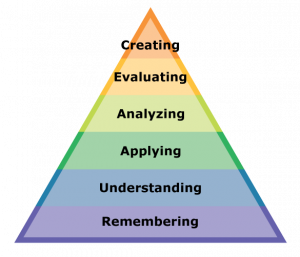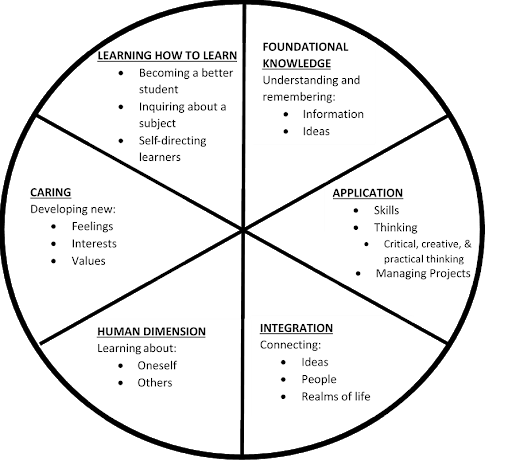Faculty Institute on Teaching
Writing Course Learning Outcomes
Why Learning Outcomes? | Bloom’s Taxonomy of the Cognitive Domain | Fink’s Taxonomy of Significant Learning | LO Improvement Activity | Examples of Strong Learning Outcomes
A note on word choice:
In higher education, we use many terms for learning outcomes including goals, objectives, qualification frameworks, standards, and more. Although there are similarities among these terms, there are also fine distinctions among them.
Our campus uses the term learning outcomes to describe what students will know or be able to do by the end of a course.
Why Learning Outcomes?
Learning outcomes help faculty and students come to a shared understanding of a course’s purpose. They are essential design tools for instructors:
- They provide a strong foundation at a course’s design stage, helping instructors plan out an effective pathway for learner success.
- During the semester, they can help instructors respond to contingencies by helping them prioritize content and activities effectively.
- In preparation for a new semester, they can help instructors refine the course or adapt it to entirely different audiences or contexts.
Learning outcomes also enable students to focus on what is important and to distinguish peripheral from essential concepts and skills. Providing clear learning outcomes can be considered an inclusive teaching practice. Some students enter college with the social capital to navigate the system—others do not. Learning outcomes can help level the playing field by clarifying expectations for all students.
Course Learning Outcomes state what students should know or be able to do at the end of the course. Typically, a class will have 3-7 course-level learning outcomes. In addition to course-level learning outcomes, you may want to have unit/module or individual class session/lecture learning outcomes. Today, we will focus on course-level learning outcomes.
Steps to create a learning outcome:
- Use student-focused language (e.g., “By the end of the course, you will be able to…”)
- Begin each learning outcome with an active verb that indicates the expected level and type of learning. You may want to consult Bloom’s Revised Taxonomy of the Cognitive Domain or Fink’s Taxonomy of Significant Learning (detailed below).
- Clearly state what you want students to know or be able to do by the end of the course.
Ensure that:
- Each learning outcome describes an action by students that is observable.
- Your learning outcomes are measurable.
TEMPLATE:
By the end of this course, you will be able to: [action verb] + [ knowledge or skill you expect students to acquire]
EXAMPLE:
By the end of this course, you will be able to:
- Explain the importance of soil microbes for globally important issues such as climate change, nutrient cycling, and biodiversity.
Revised Bloom’s Taxonomy of Learning: The “Cognitive” Domain

In 1956, Benjamin Bloom and colleagues differentiated six levels of learning in the “cognitive” domain and proposed a list of skills that would indicate understanding at each level. In 2001, Anderson, Krathwohl, and colleagues revised the taxonomy. The lowest levels (which are most commonly tested in exams) are based on knowledge of factual information. Understanding at higher levels is indicated by more complex skills in evaluation, synthesis, or the creation of new information.
Below are some verbs that represent learning at each level. For additional action verbs, see Iowa State CELT’s Bloom’s Taxonomy resource. (Here’s a backup link to that resource and its embedded pdf in case that page is down.)
| Remember | Understand | Apply | Analyze | Evaluate | Create |
| Describe | Explain | Complete | Compare/contrast | Justify | Plan |
| Name | Compare | Use | Examine | Assess | Invent |
| Find | Discuss | Examine | Explain | Prioritize | Compose |
| List | Predict | Illustrate | Identify | Recommend | Design |
| Relate | Outline | Clarify | Categorize | Rate | Construct |
| Write | Restate | Solve | Investigate | Decide/choose | Imagine |
Fink’s Taxonomy of Significant Learning

Foundational Knowledge
Understand and remember information; provides basic understanding that is needed for other types of learning
Application
Apply knowledge to action and critical, creative, and practical skills; allows other types of learning to be useful
Integration
See and understand connections between ideas, experiences, and realms of life
Human Dimension
Learn about self and others; understand the human significance of content
Caring
Change in the level of caring about something; energy and interest needed to learn more.
*For sample action verbs, see Action Verbs for Each Dimension of Fink’s Model (Teacher & Educational Development, University of New Mexico School of Medicine). Note – if the handout above doesn’t load within Canvas, we recommend opening it in another browser tab by right-clicking on the link.
Writing Learning Outcomes – continued
Reflection Activity: How can we improve the following ineffective course learning outcomes?
- You will begin to understand the purpose of the undergraduate educational experience
- Design a skyscraper
- Think critically about US politics
Examples of strong – not perfect – course learning outcomes
By the end of this course you will be able to:
- Analyze and predict fracture in terms of stress and energy.
- Discuss the history, culture, and purpose of UW-Madison and how those shared reference points may influence your Wisconsin Experience.
- Connect changing relationships among humans and animals to broader processes of economic and cultural development.
- Describe what you see and how you see. (From a course on optics!)
- Implement the close-reading skills necessary to analyze both historical and contemporary figurations of ethno-religious identity and difference.
- Discuss economic, social and legal applications of additive manufacturing.
- Explain the importance of soil microbes for globally important issues such as climate change, nutrient cycling, and biodiversity.
- Design and present a scientific poster.
- Reflect on and discuss how you contribute to campus climate.
- Compare and contrast student development theories, both verbally and in writing.
Resources for writing learning outcomes:
UW-Madison Campus resources: https://assessment.provost.wisc.edu/
Wrap-Up Reflection Questions:
- What have you learned today about course design?
- What manageable changes, if any, would you like to make now to your approach to course design?
- What changes, if any, would you like to make at a later date?
Attributions
Fink’s Taxonomy Resources adapted from:
Bloom, B.S. (Ed.) 1956. Taxonomy of Educational Objectives: The classification of educational goals. Handbook 1, Cognitive Domain. New York. (Overview online at https://www.uvic.ca/services/counselling/assets/docs/Blooms%20taxonomy.pdf)
Anderson, L.W. (Ed.), Krathwohl, D.R. (Ed.), Airasian, P.W., Cruikshank, K.A., Mayer, R.E., Pintrich, P.R., Raths, J., & Wittrock, M.C. (2001). A taxonomy for learning, teaching, and assessing: A revision of Bloom’s Taxonomy of Educational Objectives (Complete edition). New York: Longman. (Available online at https://www.depauw.edu/files/resources/krathwohl.pdf)
Fink, L. D. (2013). Creating significant learning experiences: An integrated approach to designing college courses. San Francisco, CA: Jossey-Bass.

